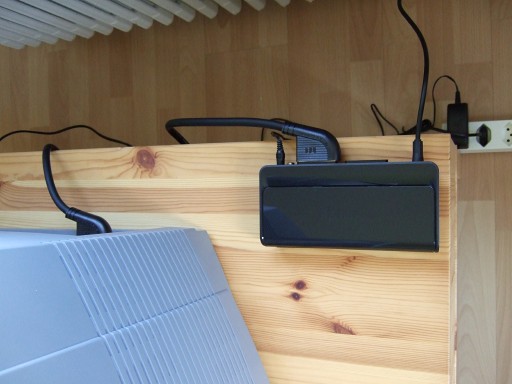The DVB-T Experiment: from free TV to cable TV and back
by René Pawlitzek, rpawlitzek@hotmail.com
From Free (analog) TV to Cable TV:
When I grew up, TV was free and people in our neighborhood used
UHF and
VHF
antennas to receive a handful of TV stations. Our family had
three channels, namely
SRG,
ARD, and sometimes (depending on the weather condition)
ZDF. Later in the eighties, pretty much all antennas disappeared from the roofs when
cable TV became popular and 30+ channels were available, some of them more useful
than others. Nowadays, one can easily receive several dozen TV stations via cable
(analog or digital) and up to a 1000(!) stations using a satellite dish.
But do you really need so many channels? The question is: how much time do
you want to waste in front of the TV? With so much annoying advertisement on all
stations, I found myself watching less and less TV. In addition, the internet offers
ways to watch TV whenever I want (e.g.:
Zattoo, etc.).
So in the end I asked myself whether it is worth to spend CHF 24.50 a month for cable TV,
something that I use only sporadically? I came to the conclusion that I should get rid off
cable TV and look for an alternative that allows me to watch news, weather forecasts, sport
events, and a few movies every now and then.
From Cable TV back to free (digital) TV:
DVB-T stands for Digital Video Broadcasting - Terrestrial. It is a technology to
broadcast TV via air. DVB-T is free in Switzerland and can be received with a minimal
amount of investment. All you need is a DVB-T receiver and an antenna. Most new flat
TVs even come with such a receiver built-in. A simple DVB-T antenna sells for less
than CHF 20.00 and an active (amplified) antenna (e.g.: Philips SDV2940) costs between
CHF 40.00 and CHF 100.00. You can also re-use your old roof antenna if you still
have it! It still works even though DVB-T is now digital and no longer analog.
In the Zurich area, you receive five free TV stations broadcasted by
SRG SSR
(the Swiss public broadcasting organisation) from the Uetliberg using a simple antenna:
|
(German) |
|
(German) |
|
(German) |
|
(French) |
|
(Italian) |
Wow, five free channels you might say and two of them not even in German. Well, TSR
and TSI regularly carry movies and sitcoms with a choice of language, one of them is
often English. So you end up with more or less five useful channels. That's pretty
much the situation during my early childhood. I was happy then and I am happy now.
So few channels also bring a big benefit. You don't find yourself channel hopping
the entire evening. If nothing interesting is shown, I simply switch off the TV set
and read a book or surf the web, call a friend or go out for a beer.
It is worth mentioning that in some areas close to Germany, Austria, Italy and France, you have a chance to
receive Swiss and foreign channels. That gives you more than enough channels for a happy life.
And with all the time and money you save on cable TV, you can buy yourself a couple of
interesting books every year to keep you entertained for quite some time.
As previously mentioned, the equipment for receiving DVB-T doesn't cost an arm and
a leg. In my case, the Philips DVR220 DVB-T receiver and the Hama 00044292 antenna set
me back CHF 70.00. That's a one time investment. No monthly fee any more. The
pictures that the Philips receiver outputs in 14:9 format onto my old TV set is outstanding,
comparable with the quality of a DVD. You don't even have to get a DVB-T receiver,
if you own a TV set with a built-in DVB-T receiver. In that case, all you need is
a simple antenna for less than CHF 20.00!
 Philips DVR220 DVB-T receiver
Philips DVR220 DVB-T receiver
 Hama 00044292 DVB-T antenna
Hama 00044292 DVB-T antenna


